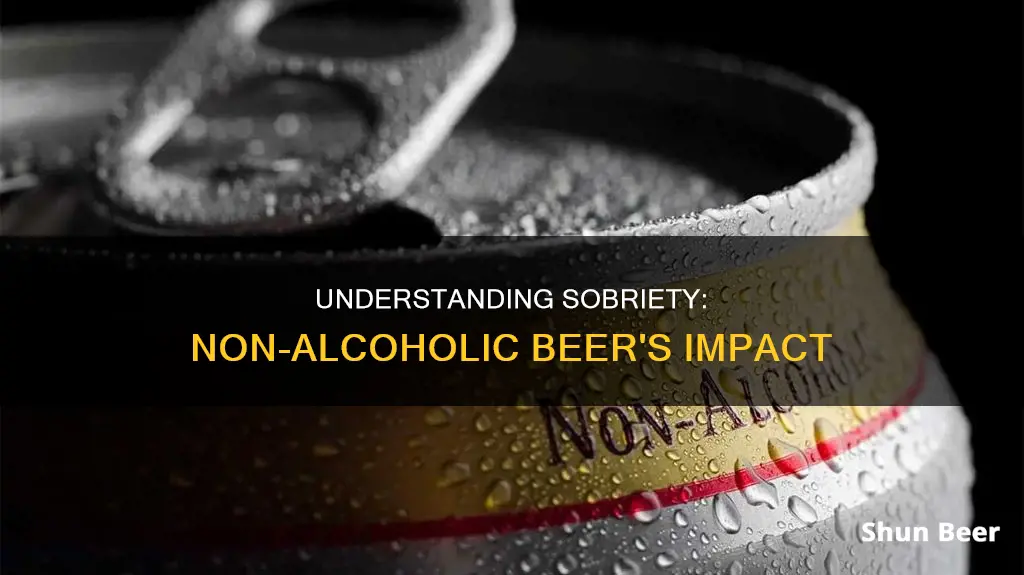
The question of whether non-alcoholic beer compromises sobriety is a complex one and depends on a variety of factors. Non-alcoholic beer, or NA beer, typically contains minimal amounts of alcohol, usually around 0.5% ABV, and is designed to taste and look like traditional beer. For individuals who are not alcoholics, NA beer is generally a safe option, as it allows them to avoid the immediate physical effects of alcohol while still enjoying the taste and social experience of drinking beer. However, for recovering alcoholics, the decision to consume NA beer is more nuanced and depends on individual triggers and circumstances. While NA beer can provide a sense of normalcy and inclusion in social settings, it may also trigger cravings and emotional associations related to past drinking experiences, potentially jeopardizing one's sobriety. Ultimately, the decision to consume NA beer during sobriety is a personal one, and individuals must carefully consider their own triggers, motivations, and support systems when making this choice.
| Characteristics | Values |
|---|---|
| Alcohol content | Non-alcoholic beer typically contains around 0.5% ABV, but can contain up to 0.5% ABV. Some non-alcoholic beers may contain more alcohol than advertised. |
| Taste and smell | Non-alcoholic beer tastes and smells like regular beer. |
| Use cases | Non-alcoholic beer is marketed as a safe alternative to alcoholic beer for those who are trying to limit their alcohol intake, are pregnant or trying to become pregnant, or have a history of alcohol abuse. |
| Risks | Non-alcoholic beer may trigger cravings and lead to a relapse for those in recovery from alcohol addiction. It may also contain enough alcohol to be unsafe for those who are pregnant or trying to become pregnant. |
What You'll Learn

Non-alcoholic beer may still contain alcohol
Non-alcoholic beer is often marketed as a safe alternative to alcoholic drinks, and it can be a good option for people who are looking to reduce their alcohol intake. However, it's important to remember that non-alcoholic beers may still contain small amounts of alcohol.
By law, non-alcoholic beers can contain up to 0.5% alcohol by volume (ABV). While this is a very small amount, it's important to note that some products labelled as 0.0% ABV have been found to contain alcohol. In fact, one study showed that 29% of no- or low-alcohol beers tested had higher alcohol levels than indicated on their labels, and six beverages labelled as 0.0% ABV were found to contain more than 1% ABV.
The amount of alcohol in non-alcoholic beers can vary, so it's important to check the labels before consuming them. This is especially important for certain groups of people, such as those with a history of alcohol use problems and pregnant or trying-to-conceive individuals.
For people with liver impairments, consuming non-alcoholic beer can result in much higher blood alcohol levels than normal, which may cause them to test positive on alcohol urine or breath tests. Additionally, the smell and taste of non-alcoholic beer may be enough to trigger cravings and a subsequent relapse among those with alcohol use disorder.
The potential presence of alcohol in non-alcoholic beers poses risks for pregnant individuals as well. According to the American College of Obstetrics and Gynecology (ACOG), pregnant individuals should avoid any alcohol consumption to eliminate the risk of fetal alcohol spectrum disorder (FASD). While FASD typically involves higher levels of alcohol consumption, the Centers for Disease Control and Prevention (CDC) states that there is no known safe amount of alcohol use during pregnancy.
In summary, while non-alcoholic beer may be a good option for some people, it's important to be aware that it may still contain small amounts of alcohol. This can pose risks for certain groups, including pregnant individuals and those with a history of alcohol use problems. Therefore, it's crucial to read labels carefully and make informed decisions about consuming non-alcoholic beers.
Drinking Beer While on Naltrexone: What You Need to Know
You may want to see also

The placebo effect of non-alcoholic beer
Non-alcoholic beer, also known as low beer, near beer, or NA beer, is often presented as a safe alternative to alcoholic drinks. However, it is important to be aware of the risks, especially for those with alcohol problems or who are pregnant. While non-alcoholic beer typically contains less than 0.5% alcohol by volume, some products may contain more alcohol than advertised.
The concept of "euphoric recall" is also relevant, where the taste of non-alcoholic beer triggers memories of the good times associated with drinking. For an alcoholic in recovery, this can be dangerous as it can lead to romanticizing the drink and a potential relapse.
The power of the placebo effect in this context was illustrated in an episode of the TV show "Freaks and Geeks". In the episode, a group of teenagers switch a keg of beer with one of non-alcoholic beer without their peers realizing. The teenagers then exhibit signs of intoxication, including slurred speech and stumbling, despite not having consumed any alcohol. This scenario demonstrates how the expectation of drinking alcohol can lead to behavioural changes, even when no alcohol is consumed.
The placebo effect relies on classical conditioning, where specific actions are triggered by associating them with particular cues. In the context of drinking, this could mean that the mere act of drinking from a keg or using red Solo cups could be enough to trigger a relapse, even if the drink is non-alcoholic.
For recovering alcoholics, the decision to consume non-alcoholic beer is a personal one and should be made with caution. While some may find it helps them feel included in social gatherings without compromising their sobriety, others may find it triggers cravings and romanticizes the drinking experience. It is crucial to know your triggers and make informed choices to maintain a successful recovery.
Beer and Flagyl: A Safe Mix?
You may want to see also

The psychological impact of non-alcoholic beer
Non-alcoholic beer is often marketed as a safe alternative to alcoholic drinks, but it's important to be aware of the potential risks involved with consuming it. While non-alcoholic beer typically contains little to no alcohol, small amounts may still be present, and it's crucial to check the labels before consumption. The psychological impact of drinking non-alcoholic beer can be complex and varies from person to person. Here are some key aspects to consider:
Impact on Sobriety
For individuals in recovery from alcoholism, the decision to consume non-alcoholic beer is a controversial topic. Some people in recovery choose to avoid non-alcoholic beer entirely to eliminate any risk of triggering a relapse. The smell and taste of non-alcoholic beer can evoke strong associations with regular beer, potentially leading to cravings and increasing the risk of relapse. The ritual and social aspects of drinking can also play a significant role in triggering a relapse, even if the beverage itself contains no alcohol.
Individual Experiences
Expectancy and Placebo Effects
Research has shown that the psychological and physical effects of consuming non-alcoholic drinks can be influenced by expectations and the placebo effect. In some cases, individuals may experience subjective feelings of intoxication or impairment even when consuming an alcohol-free beverage, simply because they believe they are drinking alcohol. This effect seems to be stronger in social contexts, where group expectations and suggestions can enhance the perceived effects.
Sleep Quality
Some studies have suggested that non-alcoholic beer can improve sleep quality. The hops in beer have a sedative effect, and consuming non-alcoholic beer at dinner has been found to improve sleep latency and overall sleep quality.
In conclusion, the psychological impact of non-alcoholic beer is multifaceted and depends on individual factors, expectations, and social context. While it may be a helpful alternative for some, it can also pose risks for those in recovery from alcoholism or with certain triggers. It's essential to make informed decisions based on personal experiences and comfort levels.
Detox and Drinking: Is Having a Beer Safe?
You may want to see also

Non-alcoholic beer as a tool for social integration
Non-alcoholic beer has a controversial reputation in recovery communities. While some people in recovery find it helpful to have a non-alcoholic drink that mimics the experience of drinking beer, others feel that it is a slippery slope that could trigger a relapse. Ultimately, the decision to consume non-alcoholic beer during sobriety is a personal one and depends on various factors.
Non-alcoholic beer can be a useful tool for social integration, allowing individuals to avoid alcohol without drawing attention to their abstinence in social settings. It can ease the social pressure and questions about not drinking, providing a sense of normalcy and inclusion. This is especially true in environments where drinking is a central activity, such as parties or social gatherings. For example, an individual might feel more comfortable ordering a non-alcoholic beer at a bar rather than a "mocktail" to avoid the risk of accidentally being served an alcoholic drink.
However, it is important to note that non-alcoholic beer is not completely alcohol-free. In many countries, beverages labelled as ""non-alcoholic" can contain up to 0.5% alcohol by volume (ABV). While this amount is generally considered negligible in terms of intoxicating effects, it can still be a concern for individuals in recovery, particularly those with specific medical conditions or court-mandated sobriety. Additionally, the taste, smell, and ritual of drinking beer, even without alcohol, can act as a psychological trigger for some people, potentially leading to cravings for alcoholic beverages.
Research on the role of non-alcoholic beer in recovery has found mixed results. While some individuals report positive outcomes such as improved social integration and reduced cravings, others have experienced adverse effects, including increased cravings or relapse. This variability underscores the importance of personalized approaches to recovery and understanding individual triggers.
In conclusion, non-alcoholic beer can be a tool for social integration, but it should be approached with caution and careful self-reflection. Individuals considering consuming non-alcoholic beer during sobriety should weigh their reasons, definition of sobriety, potential physical and psychological effects, and seek guidance from support networks and healthcare professionals. Ultimately, the goal is to support the individual's well-being and recovery journey in a way that feels comfortable and safe for them.
Sugar-Free Diets: Beer-Friendly or Foe?
You may want to see also

The risks of drinking non-alcoholic beer for pregnant people
While non-alcoholic beer is often marketed as a safe alternative to alcoholic drinks, it is important to be aware of the risks, especially if you are pregnant.
Non-alcoholic beer is usually produced by removing the alcohol from regular beer. However, some alcohol may remain in the final product. While a regular beer contains about 14 grams of alcohol, a non-alcoholic beer can contain about one gram. By law, non-alcoholic beers can have up to 0.5% alcohol by volume (ABV). However, products marketed as alcohol-free must contain 0% ABV, with no detectable levels of alcohol.
Despite these regulations, research suggests that many non-alcoholic beers contain more alcohol than their labels indicate. A 2010 study found that 29% of no- or low-alcohol beers tested had higher alcohol levels than stated on the label. Of the zero-alcohol beers sampled, six were found to have alcohol levels higher than one percent, with some even reaching 1.8%.
The potential presence of alcohol in non-alcoholic beers poses a risk to pregnant individuals. The American College of Obstetrics and Gynecology (ACOG) recommends that pregnant individuals avoid any alcohol consumption to prevent the risk of fetal alcohol spectrum disorder (FASD). While FASD typically involves higher levels of alcohol consumption, the Centers for Disease Control and Prevention (CDC) states that there is no known safe amount of alcohol use during pregnancy. Alcohol use during pregnancy can lead to birth defects, including low body weight, facial abnormalities, physical problems, and neurobehavioral disorders.
Additionally, non-alcoholic beers may contain other ingredients that are not safe for pregnant individuals. For example, some non-alcoholic beverages contain ashwagandha, also known as Indian ginseng, which pregnant people are advised to avoid.
Therefore, while non-alcoholic beer might seem like a tempting option during pregnancy, it is essential to be aware of the potential risks. To eliminate the risks associated with alcohol consumption during pregnancy, it is recommended to choose alcohol-free mocktails or drinks labeled "alcohol-free," which are required by law to contain no traceable alcohol.
In summary, the risks of drinking non-alcoholic beer during pregnancy include the potential presence of alcohol, which can lead to FASD and other birth defects, as well as the possibility of other ingredients that may be unsafe for pregnant individuals. To ensure the safety of your baby, it is always better to be cautious and choose alcohol-free alternatives.
Drinking Non-Alcoholic Beer While on Plavix: Is It Safe?
You may want to see also
Frequently asked questions
Non-alcoholic beer, also known as NA beer or alcohol-free beer, is a beverage that is designed to taste and look like traditional beer but contains very minimal or no alcohol. The alcohol content is reduced to a level that falls below the legal definition of an alcoholic beverage, which in many countries is 0.5% alcohol by volume (ABV) or lower.
The answer to this question depends on the individual and their unique circumstances. While non-alcoholic beer typically contains minimal or no alcohol, it may still trigger cravings or emotional associations for individuals with a history of alcohol addiction. It is important for each person to assess their own physical and emotional triggers and make an informed decision about whether consuming non-alcoholic beer aligns with their definition of sobriety.
Non-alcoholic beer can provide a sense of normalcy and inclusion in social settings where alcohol is present. It allows individuals to participate in the social ritual of drinking without compromising their sobriety goals and can ease the social pressure and questions about not drinking. It can also be a useful tool for individuals in recovery, helping them navigate social situations where alcohol is present without feeling left out or pressured to consume alcoholic beverages.
One risk of non-alcoholic beer is that it may trigger cravings or emotional associations for individuals with a history of alcohol addiction. The taste, smell, and ritual of drinking beer, even without alcohol, can act as a trigger, potentially leading to cravings for alcoholic beverages. Additionally, research suggests that many non-alcoholic beers contain more alcohol than their labels indicate, which can pose risks for pregnant individuals and those with liver impairments.







